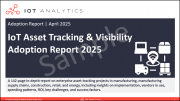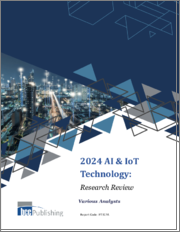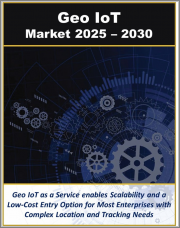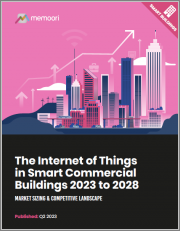
|
시장보고서
상품코드
1277028
스마트 상업 빌딩용 사물인터넷(IoT) : 시장 규모 및 경쟁 상황(2023-2028년)The Internet of Things in Smart Commercial Buildings 2023 to 2028: Market Sizing & Competitive Landscape |
||||||
본 보고서는 세계의 상업 빌딩용 IoT 시장 규모(-2028년) 및 경쟁 상황에 대한 최신 분석 결과를 정리하여 전해드립니다.
이 보고서는 상업용 부동산 시장에 초점을 맞추고 IoT 시장의 시장 규모, 용도, 기회, 주요 촉진 및 저해 요인에 대해 종합적으로 평가하고 있습니다.
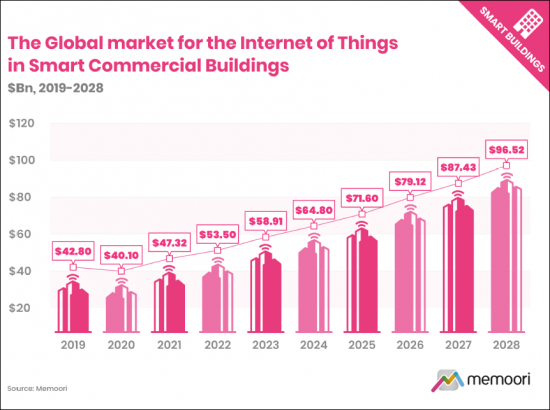
주요 질문
- 스마트 상업 빌딩용 사물인터넷(BIoT) 시장 규모는 어느 정도인가? 최근 분석에 따르면 2022년 BIoT 시장 규모는 535억 달러로 2021년 대비 13% 증가할 것으로 예상됩니다. 예상보다 느린 전반적인 경기 회복, 칩셋 부족, 공급망 혼란 등 여러 가지 요인으로 인해 실적은 13.8%로 예상보다 약간 낮았으며, 2022년부터 2028년까지 연평균 10.33%의 CAGR로 성장하여 965억 달러에 달할 것으로 예상됩니다.
- BIoT 시장 도입의 촉진요인은 무엇인가? 부동산 관계자들은 자산의 지속가능성을 높이는 것뿐만 아니라, 자산의 성과를 개선하고 임대료와 수익률을 향상시키기 위해 투자하고 있습니다. 에너지 비용 상승이 계속될 것으로 예상되기 때문에 에너지 효율이 높은 기술과 지속가능한 솔루션에 집중하는 것이 많은 기업들에게 중요한 우선순위가 될 것으로 보입니다.
- BIoT 시장이 직면한 과제와 장벽은 무엇인가? 사이버 보안은 사이버 공격에 취약한 스마트 빌딩이 증가함에 따라 매우 중요한 고려 사항입니다. 스마트 빌딩의 시스템 및 장비에는 동적 패치 기능이 없는 경우가 많으며, 시설 관리팀은 사이버 보안을 관리하는 데 필요한 IT 기술이 부족한 경우가 많습니다.
건축 산업은 지속가능한 발전과 에너지 소비 감소를 향해 전진하고 있습니다. The EIA의 2018년 CBECS 소비 및 지출 조사에 따르면, 상업 빌딩의 평방피트당 에너지 소비량은 2012년에 비해 2018년에 12% 감소했습니다. 그러나 건물과 빌딩 건설은 전 세계 에너지 소비의 3분의 1, CO2 배출량의 40%를 차지하기 때문에 건물 부문은 아직 미래의 지속가능한 발전에 필요한 목표에 도달하지 못했습니다.
2050년까지 제로에너지를 달성하기 위해 건물 소유주와 운영자는 신축과 개보수에서 더 많은 노력을 기울여야 하며, IEA는 현재 1% 미만인 개보수 비율을 2030년까지 매년 2.5%씩 증가시킬 것을 요구하고 있습니다.

본 보고서에 언급된 IoT 관련 기업: (일부)
|
|
목차
서문
주요 요약
제1장 서론
- 스마트 상업 건물용 IoT 시장 개요
- BIOT 공급망
제2장 시장 규모와 지역 분석
- 세계의 BIoT 시장 예측
- 시장 매출 : 하드웨어별·소프트웨어별·서비스별
- 시장 매출 : 업종별
- 시장 매출 : 용도별
- BIoT 시장 분석 : 지역별
- 지역별 비교
- 북미
- 라틴아메리카
- 아시아태평양
- 유럽
- 중동 및 아프리카
제3장 BIoT 시장 용도
- 보안·접근 제어
- 비디오 감시
- 비디오 관리 시스템(VMS)
- VSaaS(서비스로서의 비디오 감시)
- 접근 제어
- 보안과 접근 제어를 위한 AI 애플리케이션
- 에너지 관리와 환경 제어
- 에너지 관리에서 IoT와 AI의 역할
- 실시간 에너지 추적·분석
- HVAC 최적화
- 우선순위 균형 조정 및 여러 시스템 통합
- 에너지 관리와 환경 제어의 미래
- 그리드 인터랙티브 건물
- 수요반응과 부하 관리
- 수요측 관리 전략
- 부하 제한과 피크 쉐이빙
- 재생에너지와 PEV 통합
- 그리드 인터랙티브 빌딩 주요 기업
- 스마트 운영·정비
- 공간·점유·사람 이동
- 대기질
- 위생·건강·웰니스
- 스마트 조명
- 임차인과 직장에서의 경험
- 화재와 안전
- 폐기물과 물 관리
- 물 관리
- 폐기물 관리
- 디지털 트윈
- 디지털 트윈 정의
- 디지털 트윈·BIM(건물 정보 모델링)·IoT 관계
- 디지털 트윈 3D 모델링
- 과제와 비판
- 디지털 트윈을 성공시키기 위한 가정
- 시장 인식과 도입률
- 디지털 트윈 벤더
제4장 스마트 빌딩용 IoT 플랫폼
- IoT 플랫폼
- BIoT 플랫폼 생태계
- BIoT 플랫폼 제품
제5장 시장 전망과 이용 사례 : 시장 분야별
- 상업 오피스
- 소매업
- 소매업 실적
- 소매업 잠재성
- 소매업에서의 IoT 기회
- 호스피탈리티
- 호텔
- 레스토랑·푸드서비스
- 데이터센터
- 기타 업종
- 수송
- 공공 집회/회장
- 창고
- 소규모의 건물
제6장 BIoT 시장 - 보급 촉진요인
- 경제면·비지니스 면에서의 촉진요인
- 운영 비용 절감과 효율 향상
- 임차인 우선순위와 자산가치
- 직장 요구와 기대
- 기술면에서의 촉진요인
- 기술 비용
- 데이터량과 접근성
- 신기술
- 에너지 효율과 지속가능성 원동력
- 상업 건물 부문의 지속가능성 실적
- 개선의 중요성
- 기업 자세·투자·대처
- 에너지 비용 관련 요인
- ESG 보고서
- IoT 악영향에 대한 대응
- 건강면·복지면에서의 촉진요인
- 정부 정책과 규제
- 환경 및 지속가능성에 관한 규제
- 정부 장려금과 보조금
- IoT, 데이터, 사이버 보안 규제
- 기타 투자면·정책면에서의 촉진요인
- 규격과 인증
- 건축 기준·인증 상황 변동
- 스마트·디지털 접속
- 지속가능성, 에너지, ESG 실적
- 건강과 복지
- 사이버 보안 기준과 요건
제7장 BIoT 시장 : 과제와 장벽
- 기술면에서의 과제
- 사이버 보안
- 사이버 보험
- 데이터 프라이버시
- 시스템 복잡성과 상호운용성
- 데이터 관련 과제
- 변화에 대한 저항과 업계 진화
- CRE 업계의 변화에 대한 저항
- 업계 진화와 이동 촉진요인
- 리더십·시운전·조달
- IoT 프로젝트 리더와 의사결정자
- 수명주기 구축
- 시운전, 조달, 관계자 조정
- 시운전과 조달 과제
- 건물 수명주기 전체에 걸친 이해관계자의 우선사항
- 관계자 조정 달성
- IoT 기술과 건물 설계의 효과적인 통합
- IT·OT 이해관계자
- 임대인/임차인당 인센티브
- 비용과 사업 사례 동향
- IoT 프로젝트 비용
- 사업 사례 동향
제8장 경쟁 상황
ksm 23.06.20This Report is a new 2023 Study which Makes an Objective Assessment of the Commercial Building IoT Market Size & Competitive Landscape to 2028
Our new report focuses on market sizing, applications and opportunities in the Internet of Things market, as well as a comprehensive evaluation of the drivers and barriers to adoption that are specific to the Commercial Real Estate sector.
New for 2023, it INCLUDES at no extra cost, a spreadsheet containing the data from the report AND high-resolution presentation charts showing the key findings. It is the second instalment of a two-part series, with the first report (published last month) covering IoT Device Projections, Adoption & Meta-Trends Analysis. These reports are included in our 2023 Premium Subscription Service.

KEY QUESTIONS ADDRESSED:
- What is the Size of the Internet of Things Market in Smart Commercial Buildings (BIoT)? Our latest analysis indicates that the BIoT market grew to $53.5 billion in 2022, representing a 13% rise from 2021. Performance was slightly down from our forecast of 13.8% for the year due to several factors, including a slower-than-anticipated overall economic recovery, a lack of chipsets, and disrupted supply chains. Memoori forecasts that the BIoT market size will grow at a CAGR of 10.33% to $96.5 billion between 2022 and 2028.
- What is Driving BIoT Market Adoption? Real estate stakeholders are investing not only to improve the sustainability credentials of their assets but also to enhance their performance, resulting in better rent and yields. As rising energy costs are expected to continue increasing, the focus on energy-efficient technologies and sustainable solutions is likely to remain a significant priority for many companies.
- What Challenges & Barriers Does the BIoT Market Face? Cybersecurity is a crucial consideration for the growing number of smart buildings, which are increasingly susceptible to cyber attacks. Smart building systems and devices often lack dynamic patching capabilities, and facilities management teams may lack the IT skills required to manage cybersecurity.
The building sector is making progress towards sustainable development and reducing energy consumption. The EIA's 2018 CBECS consumption and expenditures survey found that commercial buildings consumed 12% less energy per square foot of floorspace in 2018 than in 2012. However, the building sector still falls short of the targets required for sustainable future development, as buildings and building construction contribute to one-third of global energy consumption and almost 40% of CO2 emissions.
To achieve net zero by 2050, building owners and operators must redouble their efforts in new construction and retrofits. The IEA is now calling for an increase in retrofit rates of 2.5% annually by 2030, up from less than 1% today.
WITHIN ITS 236 PAGES AND 26 CHARTS AND TABLES, THE REPORT FILTERS OUT ALL THE KEY FACTS AND DRAWS CONCLUSIONS, SO YOU CAN UNDERSTAND EXACTLY WHAT IS SHAPING THE FUTURE OF THIS GLOBAL IOT MARKET
- The Building Internet of Things market is complex and multifaceted, involving a wide range of players from traditional building automation companies to specialized manufacturers, ICT vendors, property firms, and software vendors offering middleware, platforms, and cloud-based data analytics services. While some companies offer end-to-end BIoT solutions, others specialize in specific areas such as data intelligence, automation, or energy optimization and analytics.
- The smart building startup landscape is also expanding rapidly, with a 20% increase in the number of new entrants founded since 2021. Consolidation is expected in the wider platforms space, but there remain considerable market opportunities for cloud-based software offerings for specialist applications or vertical markets.
- While the level of fragmentation in the BIoT market can act as a source of confusion and frustration for buyers, leading platform solution providers are beginning to emerge, and the user base seems likely to coalesce around a more limited number of platform providers.
This report provides valuable information to companies so they can improve their strategic planning exercises AND look at the potential for developing their business through mergers, acquisitions and alliances.
WHO SHOULD BUY THIS REPORT?
The information contained in this report will be of value to all those engaged in managing, operating and investing in commercial smart buildings (and their advisers) around the world. In particular, those wishing to understand exactly how the Internet of Things is impacting commercial real estate will find it most useful.
ALIGNING STAKEHOLDER PRIORITIES
The infographic below illustrates key stakeholders in a smart building project, their priorities and KPIs, and the project phases they might be involved in under traditional and best practice approaches. Encouraging collaboration, communication, and standardized practices among stakeholders can help bridge the gap and foster innovation.
The integration of Internet of Things technology into building design is a complex process that requires coordination and alignment among all parties involved. A comprehensive and cohesive design approach involving key stakeholders from the earliest stages leads to improved decision-making and better outcomes .
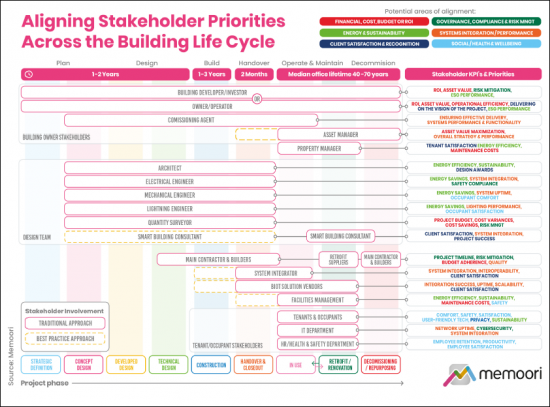
Internet of Things Companies Mentioned INCLUDE: (but NOT limited to)
|
|
Table of Contents
Preface
The Executive Summary
1. Introduction
- 1.1. Overview of the IoT Market in Smart Commercial Buildings
- 1.2. The BIOT Supply Chain
2. Market Sizing and Regional Analysis
- 2.1. BIoT Global Market Forecasts
- 2.1.1. Market Revenue by Hardware, Software & Services
- 2.1.2. Market Revenue by Vertical
- 2.1.3. Market Revenue by Application
- 2.2. BIoT Market Analysis by Region
- 2.2.1. Regional Comparisons
- 2.2.2. North America
- 2.2.3. Latin America
- 2.2.4. Asia Pacific
- 2.2.5. Europe
- 2.2.6. Middle East & Africa
3. BIoT Market Applications
- 3.1. Security & Access Control
- 3.1.1. Video Surveillance
- 3.1.2. Video Management Systems (VMS)
- 3.1.3. Video Surveillance as a Service (VSaaS)
- 3.1.4. Access Control
- 3.1.5. AI Applications for Security & Access Control
- 3.2. Energy Management & Environmental Control
- 3.2.1. The Role of IoT and AI in Energy Management
- 3.2.2. Real-Time Energy Tracking and Analysis
- 3.2.3. HVAC Optimization
- 3.2.4. Balancing Priorities and Integrating Multiple Systems
- 3.2.5. The Future of Energy Management and Environmental Control
- 3.3. Grid Interactive Buildings
- 3.3.1. Demand Response and Load Management
- 3.3.2. Demand-Side Management Strategies
- 3.3.3. Load Shedding and Peak Shaving
- 3.3.4. Integrating Renewables and PEV's
- 3.3.5. Leading Players in Grid Interactive Buildings
- 3.4. Smart Operations & Maintenance
- 3.5. Space, Occupancy & People Movement
- 3.6. Air Quality
- 3.7. Hygiene, Health & Wellness
- 3.8. Smart Lighting
- 3.9. Tenant & Workplace Experience
- 3.10. Fire & Safety
- 3.11. Waste & Water Management
- 3.11.1. Water Management
- 3.11.2. Waste Management
- 3.12. Digital Twin
- 3.12.1. Defining Digital Twins
- 3.12.2. The Relationship Between Digital Twins, BIM & IoT
- 3.12.3. 3D Modelling for Digital Twins
- 3.12.4. Challenges & Criticisms
- 3.12.5. Prerequisites for Successful Digital Twins
- 3.12.6. Market Perceptions & Adoption Rates
- 3.12.7. Digital Twin Vendors
4. Smart Building IoT Platforms
- 4.1. IoT Platforms
- 4.2. The BIoT Platform Eco-System
- 4.3. BIoT Platform Offerings
5. Prospects & Use Cases by Market Vertical
- 5.1. Commercial Offices
- 5.2. Retail
- 5.2.1. Retail Sector Performance
- 5.2.2. The Future of Retail
- 5.2.3. Retail Sector IoT Opportunities
- 5.3. Hospitality
- 5.3.1. Hotels
- 5.3.2. Restaurants & Food Services
- 5.4. Data Centers
- 5.5. Other Verticals
- 5.5.1. Transport
- 5.5.2. Public Assembly/Venues
- 5.5.3. Warehouses
- 5.6. Smaller Buildings
6. BIoT Market - Adoption Drivers
- 6.1. Economic & Business Drivers
- 6.1.1. Operational Cost Savings and Efficiency Gains
- 6.1.2. Tenant Priorities & Property Value
- 6.1.3. Workplace Demands & Expectations
- 6.2. Technology Drivers
- 6.2.1. Technology Costs
- 6.2.2. Data Volume & Accessibility
- 6.2.3. Emerging Technologies
- 6.3. Energy Efficiency & Sustainability Drivers
- 6.3.1. Sustainability Performance in the Commercial Building Sector
- 6.3.2. The Critical Importance of Retrofits
- 6.3.3. Corporate Attitudes, Investments, and Initiatives
- 6.3.4. Energy Cost-related Drivers
- 6.3.5. ESG Reporting
- 6.3.6. Countering the Adverse Impacts of the IoT
- 6.4. Health & Wellbeing Drivers
- 6.5. Government Policies & Regulations
- 6.5.1. Environmental and Sustainability Regulations
- 6.5.2. Government Incentives and Subsidies
- 6.5.3. IoT, Data & Cybersecurity Regulations
- 6.5.4. Other Investment or Policy Drivers
- 6.6. Standards & Certification
- 6.6.1. The Evolving Landscape of Building Standards & Certifications
- 6.6.2. Smart & Digital connectivity
- 6.6.3. Sustainability, Energy & ESG performance
- 6.6.4. Health & Wellbeing
- 6.6.5. Cybersecurity Standards and Requirements
7. BIoT Market - Challenges & Barriers
- 7.1. Technology Challenges
- 7.1.1. Cybersecurity
- 7.1.2. Cyber Insurance
- 7.1.3. Data Privacy
- 7.1.4. Systems Complexity & Interoperability
- 7.1.5. Data Related Challenges
- 7.2. Resistance to Change and Industry Evolution
- 7.2.1. Resistance to Change in the CRE Industry
- 7.2.2. Industry evolution and transition drivers
- 7.3. Leadership, Commissioning & Procurement
- 7.3.1. IoT Project Leadership & Decision Makers
- 7.4. Building Life Cycles
- 7.5. Commissioning, Procurement & Stakeholder Alignment
- 7.5.1. Commissioning & Procurement Challenges
- 7.5.2. Stakeholder Priorities Across the Building Life Cycle
- 7.5.3. Achieving Stakeholder Alignment
- 7.5.4. Effective Integration of IoT Technology into Building Design
- 7.5.5. IT vs OT Stakeholders
- 7.5.6. Landlord/Tenant split incentives
- 7.6. Costs & Business Case Development
- 7.6.1. IoT Project Costs
- 7.6.2. Business Case Development






